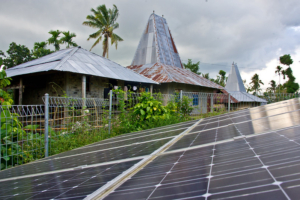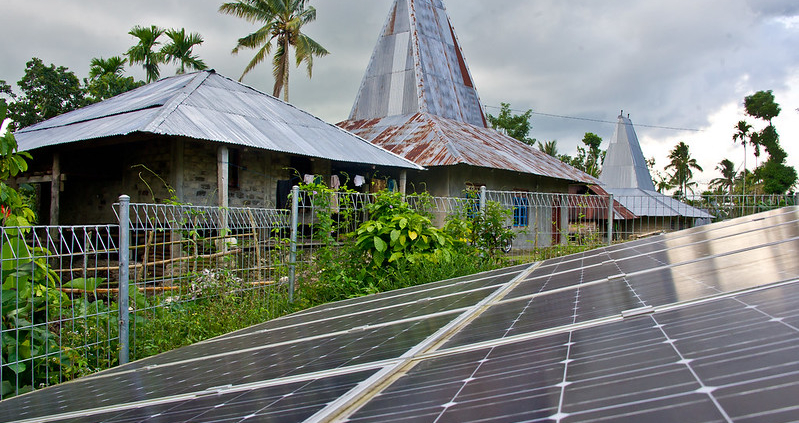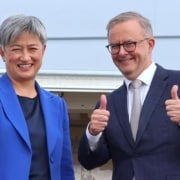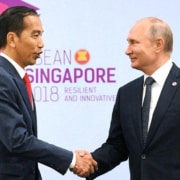
Solar will be the focus point of Indonesia’s energy transition. Photo by the Asian Development Bank from Flickr.
Indonesia’s Just Energy Transition Partnership (JETP) is a fund of up to US $20 billion earmarked for investment in clean energy over the next three to five years. Indonesia signed onto the deal with the International Partners Group – led by the US and Japan – at the G20 summit in 2022.
As part of its obligations under this framework, Indonesia released a Comprehensive Investment and Policy Plan (CIPP) that details a roadmap for reaching peak emissions in 2030 and becoming net zero by 2050.
Under the scenario modelled in the CIPP, solar is expected to be the major new source of electricity in Indonesia. It needs to grow rapidly from 0.1% of energy generation in 2022 to 8% by 2030. Geothermal, hydropower and bioenergy also need to grow rapidly. Electricity generated by all forms of renewable energy is expected to increase from 13% in 2022 to 44% in 2030.
As more renewable energy comes into service, coal will gradually be phased out but will remain an important power source for the near-term.
Private investment requires market reforms
To meet these ambitious goals, the private sector will play a leading role in project finance and development. Indonesia and its state-owned electricity utility, PLN, do not have a great track record when it comes to inducing private sector development of renewable energy, especially wind and solar. The CIPP recommends a number of market-oriented reforms to accelerate this process and ensure that this time, things will be different.
One key reform involves the price of coal. Because Indonesia has large coal reserves, the government caps the price at which coal can be sold to domestic power plants, generally at below market rates. As coal is Indonesia’s primary source of electricity generation, controlling the price of this fuel input reduces generating costs and helps keep the retail cost of electricity low.
The CIPP is pushing hard for this price cap to be removed, and for coal to be bought and sold domestically at its true market price. The reasoning here is that the more expensive coal is, the less attractive it becomes as a source of electricity generation.
A second reform targets PLN’s business model. In Indonesia the price consumers pay per kWh of electricity is fixed depending on the type of customer and the service, and it usually does not change even if PLN’s expenditures increase. This means PLN often operates at a large annual loss, and the government covers these losses through various means, including subsidies.
This is by design. Much like the cap on coal prices, the goal is to ensure that higher costs are not passed onto consumers. The CIPP calls for PLN to do away with this system and adopt a “forward-looking revenue model” that better accounts for the true cost of generating electricity. Such a reform would almost certainly require consumers to pay higher prices.
A third reform involves PLN’s role in private investment and the development of renewable energy. PLN owns and operates Indonesia’s national transmission and distribution system, and when private developers enter the Indonesian market, they have to sell their power to PLN. There are no other buyers because PLN has a monopoly over distribution. Therefore, before a financial institution will agree to finance such a project, the developer usually must reach a Power Purchase Agreement (PPA) with PLN that establishes the terms on which the utility will buy the power.
The CIPP makes numerous recommendations for how PLN can make these agreements (and the procurement process in general) more “bankable” – meaning, more attractive to commercial financial institutions and private developers. The main theme of these recommendations is to shift a greater share of the risk from the seller (the project developer) onto the buyer (PLN and, ultimately, the government of Indonesia), through various mechanisms.
The CIPP also recommends that PLN handle many of the more challenging steps in project development, such as feasibility studies and land acquisition, and then offer a project for tender to developers once much of the legwork has already been done. This, along with the ‘de-risking’ provisions, would certainly make projects more attractive to private investors and developers. But whether it is something PLN is able and willing to do, and what they might expect to receive in return, is another question.
The CIPP envisions mobilising private finance to develop renewable energy at scale using a mix of conventional market tools. The state is being asked to ‘de-risk’ a portion of these investments, and PLN is expected to evolve into something resembling a conventional commercial enterprise. The CIPP estimates that Indonesia will need $96 billion of investment in renewable energy and grid improvements between now and 2030, and increased tariffs on consumers will help pay for this accelerated development.
More closely matching the price of electricity with production costs is intended to better inform long-term investment, planning and procurement decisions and make them more responsive to market conditions. Because technologies like solar are becoming increasingly inexpensive to build and operate, in a competitive market price signals will naturally shift investment toward renewables because they are cheaper than coal.
For this plan to work as envisioned, Indonesia’s energy sector must be made to function more like an efficient and competitive market. This is why the CIPP is pushing hard to remove the price cap on coal. If domestic power plants can continue to obtain coal at below market value due to government intervention, then prices are useless as signals because they do not reflect economic reality.
Politics may trump markets
Historically, price signals set by markets have not been particularly effective in the Indonesian energy sector. In fact, one of the explicit goals of energy policy in Indonesia is to buffer consumers from the true cost of energy generation. The Indonesian government wants to deliver electricity to consumers at low and stable prices, insulated from swings in commodity prices and other externalities.
The ability to cap the domestic price of coal is attractive to policymakers for this very reason. After the pandemic, when coal prices were skyrocketing around the world, electricity bills in Indonesia did not move much. That is because PLN – and, ultimately, the government – was eating the losses and the price of coal was being artificially held down.
Control of prices is a powerful policy lever to have and not one the government of Indonesia is likely to give up easily. They will be extremely resistant to any policy framework where consumers are expected to bear increased operating and investment costs because of the political implications of price increases. The country saw widespread protests when it tried to slash fuel subsidies in 2022.
Calling for PLN and the structure of the Indonesian energy sector to be overhauled and become more responsive to price signals in just seven years is a very ambitious vision. Expecting consumers to shoulder increased costs of the energy transition while the state absorbs development risk to induce more private investment will not be an appealing proposition for the Indonesian government.
It is clear the JETP investment roadmap was written with an eye toward making Indonesia’s renewable energy sector more attractive to private capital. What is less clear is whether the plan sufficiently accounts for the reality of Indonesia’s political economy and the interests and incentives of key stakeholders like PLN as they actually are, rather than as global investors and markets wish them to be.


 https://flickr.com/photos/asiandevelopmentbank/14454539704/
https://flickr.com/photos/asiandevelopmentbank/14454539704/







 Photo from Canva
Photo from Canva